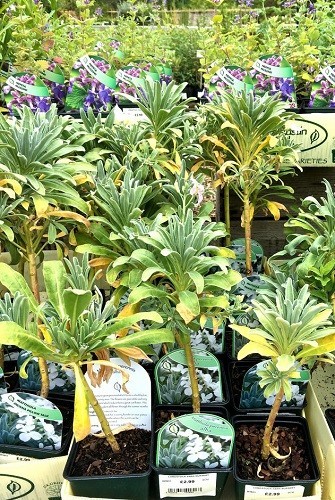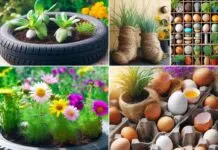Best Garden Trends for Inspiration Ideas
Gardening is a beautiful hobby that can be both therapeutic and rewarding. With the new season approaching, it is time to look into some of the latest trends and ideas that can inspire your garden design. In this article, we will explore the best garden trends for inspiration ideas to make your garden the envy of the neighborhood.
Sustainable Gardening
Sustainability is becoming increasingly important, and gardening is no exception. Sustainable gardening practices can help you conserve resources and create a healthier environment. Here are some of the best sustainable gardening trends for inspiration:
Composting
Composting is an easy way to recycle organic waste and turn it into nutrient-rich soil. Composting can reduce waste, conserve water, and promote healthy soil. You can either create a compost bin or purchase one. Composting is a simple and effective way to make your garden more sustainable.
Rainwater Harvesting
Rainwater harvesting is another sustainable gardening practice that can help you conserve water. You can collect rainwater in barrels or other containers and use it to water your garden. Rainwater is free of chemicals and additives, making it a healthy and natural option for your plants.
Use of Native Plants
Using native plants is an excellent way to promote sustainability in your garden. Native plants are well-adapted to local soil and weather conditions, making them more resilient to pests and diseases. They also require less water and fertilizer than non-native plants.
Vertical Gardening
Vertical gardening is a popular trend that can help you maximize your garden space. It involves growing plants on walls, trellises, or other vertical structures. Vertical gardening can create a stunning visual effect while conserving space.
Garden Rooms
Garden rooms are outdoor living spaces that provide a private and intimate atmosphere. Garden rooms can be designed to accommodate various activities, such as dining, reading, or relaxing. They can also be designed to complement the style of your home and garden.
Urban Farming
Urban farming is becoming increasingly popular, as people look for ways to grow their food in small spaces. Urban farming involves growing vegetables, herbs, or fruits in containers or small plots. It is a great way to reduce your carbon footprint and enjoy fresh, organic produce.
Water Features
Water features, such as fountains or ponds, can add a calming and soothing atmosphere to your garden. Water features can also attract wildlife, such as birds and butterflies. They are a great way to create a tranquil outdoor environment.
Naturalistic Gardens
Naturalistic gardens are designed to mimic the natural landscape. They typically feature native plants and a mix of textures and colors. Naturalistic gardens can create a beautiful and relaxed atmosphere.
Japanese Gardens
Japanese gardens are known for their serenity and beauty. They typically feature elements such as rocks, water, and plants. Japanese gardens can create a peaceful and meditative atmosphere.
Japanese gardens are known for their unique design and serene atmosphere. They have been a popular feature of Japanese culture for centuries, and their popularity has spread around the world. Japanese gardens are designed to create a sense of tranquility and harmony with nature, and they often incorporate elements such as water, rocks, and plants in a way that reflects the natural world.
Edible Landscaping
Edible landscaping involves incorporating edible plants into your garden design. You can grow fruits, vegetables, and herbs in a beautiful and functional way. Edible landscaping can help you save money on groceries and enjoy fresh, organic produce.
Edible landscaping is a gardening approach that combines ornamental plants with edible plants to create a beautiful and functional landscape. This practice involves designing and planting gardens that are not only aesthetically pleasing but also provide fresh fruits, vegetables, herbs, and other edible plants for the gardener’s consumption.
The concept of edible landscaping is based on the idea of using available space, including lawns, flower beds, and other areas of the landscape, to grow food. This approach can help to reduce the amount of land needed for traditional farming, promote self-sufficiency, and improve access to fresh, healthy food.
Edible landscaping can take many forms, from planting fruit trees and berry bushes to integrating vegetables and herbs into existing flower beds. It can also include features such as raised garden beds, edible hedges, and vertical gardens.
In addition to providing food, edible landscaping can also offer environmental benefits, such as reducing water use, improving soil health, and supporting pollinators and other beneficial wildlife.
Low Maintenance Gardens
Low-maintenance gardens are designed to require minimal upkeep. They typically feature plants that are easy to care for and require little water or fertilizer. Low-maintenance gardens can be a great option for those who have busy schedules or prefer to spend less time on garden upkeep.
Feng Shui Gardens
Feng shui gardens are designed to promote harmony and balance. They typically feature elements such as water, rocks, and plants arranged in a way that promotes positive energy flow. Feng shui gardens can create a peaceful and relaxing atmosphere.
Feng Shui gardens are designed according to the principles of Feng Shui, a traditional Chinese practice that aims to create a harmonious and balanced living environment. The goal of a Feng Shui garden is to create a space that promotes positive energy flow, or “chi,” through the use of natural elements and intentional design.
In a Feng Shui garden, the layout and placement of plants, rocks, and other features are carefully considered to create a sense of balance and tranquility. For example, a curved path or stream can help to slow down and redirect the flow of chi, while a water feature such as a fountain or pond can promote calm and relaxation.
Garden Lighting
Garden lighting can add a beautiful and functional element to your garden. It can highlight your plants and landscape features and create a welcoming atmosphere. Garden lighting can also improve safety and security by illuminating walkways and entrances.
Garden Art
Garden art can add a unique and personal touch to your garden. It can be anything from sculptures and mosaics to wind chimes and birdhouses. Garden art can create a focal point and add visual interest to your garden.
Garden Furniture
Garden furniture can transform your garden into an outdoor living space. It can be anything from benches and chairs to tables and lounges. Garden furniture can be made from various materials, such as wood, metal, or plastic.
Conclusion
In conclusion, there are many inspiring garden trends and ideas that can transform your garden into a beautiful and functional outdoor space. From sustainable gardening practices to vertical gardening and water features, there are many ways to create a unique and personalized garden design.
Remember to choose a style that reflects your personality and lifestyle, and don’t be afraid to experiment with different elements to create a garden that you will love.
FAQs
-
What are the benefits of sustainable gardening practices?
Sustainable gardening practices can have many benefits, both for the environment and for your personal health and well-being. They can reduce water usage, improve soil health, and decrease the use of harmful chemicals. Additionally, sustainable gardening practices can provide fresh, healthy produce that is free of harmful pesticides and chemicals.
-
How can I incorporate vertical gardening into my small space?
Vertical gardening is a great way to maximize space in a small garden. You can use trellises, wall-mounted planters, or hanging baskets to create a vertical garden. Consider using plants that grow upwards, such as tomatoes, cucumbers, or climbing vines.
-
What are some popular garden room designs?
Popular garden room designs include outdoor kitchens, fire pits, and seating areas. These garden rooms are designed to be functional and comfortable outdoor living spaces where you can entertain guests or simply relax and enjoy your garden.
-
How can I start my own urban farm?
Starting your own urban farm can be a rewarding and sustainable way to grow your own produce. Begin by researching the types of crops that grow well in your area and the local regulations and zoning laws. You may also want to consider joining a community garden or urban agriculture program for support and resources.
-
What types of plants are suitable for a low-maintenance garden?
Plants that are drought-tolerant and require minimal pruning and fertilization are suitable for a low-maintenance garden. Succulents, lavender, and ornamental grasses are popular choices for low-maintenance gardens. Native plants that are well adapted to your local climate and soil conditions are also a good option.











